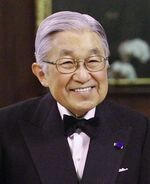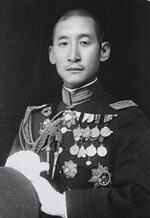User:Zhenkang/Sandbox/Royal Order of the Chrysanthemum
The Royal Order of the Chrysanthemum (大勲位菊花章) is the Bai Empire's highest-level title order. It is posthumously given by the Government of the Bai Empire for actions which are deemed to be heroic, defined as "acts of outstanding bravery or distinction which can be remembered and exemplified for all time by other citizens" or "extraordinary service furthering the interests of the state and people". Only Bai citizens are eligible for the award.
The title was first established by Emperor Guangzhi with the release of Imperial Decree No. 218 of 1821 and the first recipient of the award was his father, Emperor Chenghong, the founder of the Middle Bai Dynasty. Since then, a total of 245 men and 22 women have received the award. Briefly superseded by the Order of the Republic during the War of Fellow Brothers, the award was reinstated in 1962 during the Imperial Restoration.
Recipients List
| | |
|---|---|
| Birth: 1752, Bai Empire | Death: 1819 |
| Other names: Hu Fengyao 胡风耀 | |
| Huangdi 皇帝 | |
| Emperor Chenghong, personal name Hu Fengyao and also known colloquially as Prince Hu, was a Bai monarch who founded the Middle Bai Dynasty. Reigning as the first Emperor of Middle Bai from 1798 to 1819, he was the first Bai Emperor to institute and implement a democratic constitutional government. Due to his legacy in restoring Bai's status as a regional power and establishing a democratic system, he remained one of the most widely-revered figures in Bai history. Born in 1752, he was the nephew of the last reigning Lin Emperor Rentong. His exile overseas, particularly in Mauretia and the Federal States, led to him embracing democratic ideals and establishing his political philosophy of Bai Democracy (Bairen Minzhu). In the 1770s, rallying with overseas Bai intellectuals, he emerged as the leading figure calling for the overthrowing of the Lin Dynasty and the establishment of a democratic constitutional monarchy. Returning to Bai in 1780, he was immediately placed under house arrest by his cousin, who saw him as a contender to the throne. Prince Hu ascended the throne as the Chenghong Emperor following the Huifu Restoration in 1798. As Emperor, he enacted the Chenghong Constitution which established the constitutional government still existing today. Under him, Bai grew more independent of its Ulethan overlords, transforming into a regional power and managing to renegotiate trade treaties with Ulethan powers. The Empire underwent rapid modernisation and reformation as Prince Hu championed respect for civil rights and vibrant economic growth. Hu eventually died of gallbladder cancer in 1819. | |
| | |
|---|---|
| Birth: 31 August 1901, Huoyuan, Bai Empire | Death: 4 June 1989 |
| Yu Zeming (Baiyu: 于泽冥; 31 October 1901 – 4 June 1989) was a Bai prince, revolutionary and military leader who ruled Bai as its Crown Regent from 1962 to 1989. Having reunified Bai through the Eastern Expedition and restored the monarchy, he continued to preside over Bai's redevelopment and oversaw its transformation into a developed country and regional power in Northern Archanta. His rule was commonly known as the Regency Era, which has been criticised as authoritarian, with mass persecution of political critics, purging of other warlords and imposition of martial law over certain areas of the country. Born in Huoyuan, Neilu Province, Yu was initially a member of his father's Bai Fascist Solidatory Party (BFSP). Following political differences with his father, he and his wife Chang Meisheng defected from the regime and remained in Izaland for the remainder of the fascist era. Returning to Bai in the 1950s, he established a new government and organised a coalition of forces (including warlords of Fascist remnants) known as the New Alliance for the Reunification of the Bai People. As commander-in-chief, he led the Eastern Expedition, defeated the various factions and reunified Bai in 1962. Through a referendum, he restored the Bai monarchy but installed his son as the de jure head of state while he continued to rule as the country's de facto leader. Under his tenure as Crown Regent, he began his Weixin Programme to reconstruct and re-develop Bai through restoring and modernising the national road and rail systems and establishing new economic zones for trade with the outside world. The re-establishment of ties with foreign powers and foreign-direct investments of the 60s and 70s led to the recovery of the Empire's economy, which became industrialized and technology-oriented. In the 80s, he began to delegate more authority to his son, and successfully bided and hosted the Xiongjing Pax Nova Games in 1988. Shortly after, on 4 June 1989, he died of a fatal stroke and was given a royal funeral. He was buried in a masoleum∈⊾ on the hill along with the other former Middle Bai Emperors. | |
| | |
|---|---|
| Birth: 5 July 1941, Saindaul, Izaland | Death: 10 October 2022, Xiongjing, Bai Empire |
| Other names: Yu Jianshi 于坚石 | |
| Huangdi 皇帝 | |
| Emperor Fengyang (Baiyu: 丰阳帝), personal name Yu Jianshi (Baiyu: 于坚石), was the monarch of the Bai Empire. While he ascended the throne in 1962, he only assumed its executive powers in 1989. His father, Yu Zeming, ruled on his behalf as Crown Regent during the Regent Era. He is the only son of Princess Chang Meisheng and the grandson of the last Middle Bai Emperor Yongren. Born in 1941 during the War of Fellow Brothers, he was raised and educated in Izaland when his father defected from the Fascist regime. Through arrangements for Bai's political future, Yu was made Emperor of Bai, though his executive powers were discharged to his father. In the early years of his reign, he returned to Izaland to complete his studies and married Izaki Mahkaui Tyen Hoina, and only returned to Bai in 1971. During the 70s and 80s, he slowly assumed administrative and ceremonial duties, in preparation to take over his father as leader. | |


